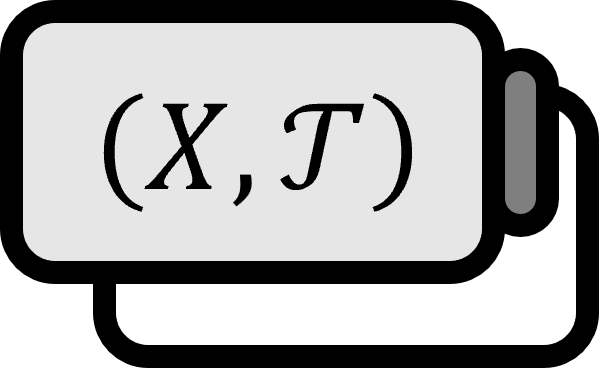Separated Union Topological Space
Definition
Let $\left\{ X_\alpha \right\}_{\alpha \in A}$ be an arbitrary topological space index family. Let us say $u \subset \bigsqcup \limits_{\alpha \in A} X_\alpha$. Then, for all $\alpha \in A$, if $u \cap X_\alpha$ is an open set in $ X_\alpha$, then $u$ is said to be an open set $^{\ast}$ in $\bigsqcup \limits_{\alpha \in A} X_\alpha$.
- The so-called open$^{\ast}$ here is not exactly open in the sense of topology. However, by collecting subsets $u$ that satisfy such conditions, one can verify that it actually becomes a topology of $\bigsqcup \limits_{\alpha \in A}X_\alpha$. Thus, it is called open.
Theorem
The Disjoint Union as a Topology
Let $\mathcal{T}$ be a collection of open$^{\ast}$ subsets in $\bigsqcup \limits_{\alpha \in A}X_\alpha$. And let $\mathcal{T}_\alpha$ be the topology of $X_\alpha$.
- $(0)$: Then $\mathcal{T}$ is the topology of $\bigsqcup \limits_{\alpha \in A}X_\alpha$ and this is called the disjoint union topology.
Properties of the Disjoint Union Topology
Let $\bigsqcup \limits_{\alpha \in A} X_\alpha$ be a disjoint union topological space. Then
- $(a)$: Let $Y$ be any topological space. Then, it is equivalent that $f\ :\ \bigsqcup \limits_{\alpha \in A} X_\alpha \rightarrow Y$ is continuous and both $\forall\ \beta\in A$, $f\circ \iota\ :\ X_\beta \rightarrow Y$ are continuous.
- $(b)$: The disjoint union topology is the unique topology on $\bigsqcup \limits_{\alpha \in A} X_\alpha$ that satisfies $(a)$.
- $(c)$: A subset $F \subset \bigsqcup \limits_{\alpha \in A} X_\alpha$ being a closed set is equivalent to $F\cap X_\alpha$ being a closed set in $X_\alpha$ for all $\alpha \in A$.
Proof
$(0)$
Strategy: The proof directly confirms whether it satisfies the three conditions to be a topology.
$(1)$
For $\varnothing, \bigsqcup \limits_{\alpha \in A}X_\alpha$ and all $\alpha \in A$, we have $$ \varnothing \cap X_\alpha=\varnothing \in \mathcal{T}_\alpha \\ \left( \bigsqcup \limits_{\alpha \in A}X_\alpha \right) \cap X_\alpha=X_\alpha \in \mathcal{T}_\alpha $$ therefore $$ \varnothing, \bigsqcup \limits_{\alpha \in A}X_\alpha \in \mathcal{T} $$
$(2)$
Let us denote $u_{i} \in \mathcal{T},\quad \forall\ i\in \mathbb{N}$. Then, by definition, we have $$ u_{i}\cap X_\alpha \in \mathcal{T}_\alpha,\quad \forall\ i\in \mathbb{N} $$ However, $$ \left( \bigcup \limits_{i=1}^\infty u_{i}\right)\cap X_\alpha=\bigcup \limits_{i=1}^\infty \left( u_{i} \cap X_\alpha \right) $$ and since the countable union of open sets is an open set, $$ \left( \bigcup \limits_{i=1}^\infty u_{i} \right) \cap X_\alpha \in \mathcal{T}_\alpha $$ thus $$ \bigcup \limits_{i=1}^\infty\ u_{i} \in \mathcal {T} $$
$(3)$
Let us denote $u_{1}, u_2 \in \mathcal{T}$. Then, by definition, we have $$ u_{i}\cap X_\alpha \in \mathcal{T}_\alpha,\quad i=1,2 $$ However, $$ (u_{1} \cap u_2)\cap X_\alpha=u_{1}\cap u_2\cap X_\alpha \cap X_\alpha=\left( u_{1}\cap X_\alpha \right) \cap \left(u_2\cap X_\alpha \right) $$ and since the intersection of open sets is also an open set, $$ \left( u_{1} \cap u_2 \right) \cap X_\alpha \in \mathcal{T}_\alpha $$ thus $$ u_{1}\cap u_2 \in \mathcal {T} $$
■
